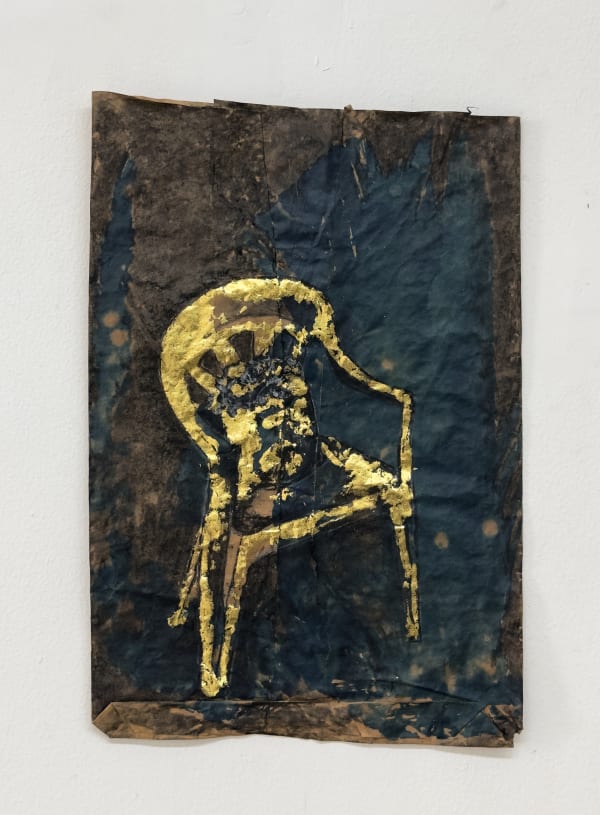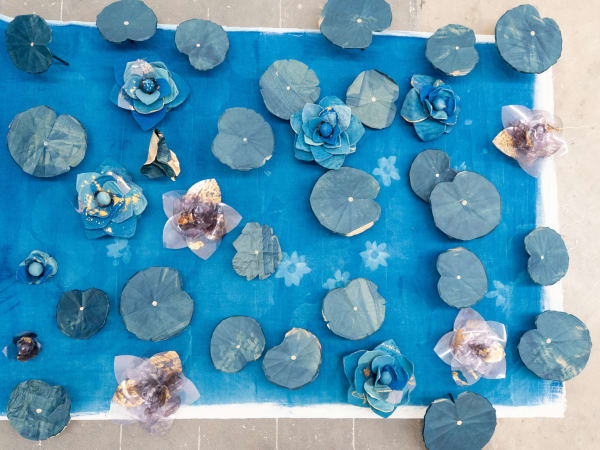Aṟṟa Kuḷamum, Koṭṭiyum, Āmpalum: Lojithan Ram
Wading through the certainty of impermanence, Arra Kuļamum, Kottiyum, Āmpalum seeks to revisit family archives not as mere static records, but as embodiments of tender longing. Haunting apparitions of landscapes and family photographs—strewn with blooming lotuses and resonant with the cadence of ritual hymns—become necessary shelter in Ram’s cyanotypes and sculptures. These elements act as emotional and spiritual anchors, constructing a space of imagined return. Yet, even as the imagery invites rumination, they are underscored by a persistent sense of unmooring. The artist imbues each artwork with the hushed ache of impermanence - the painful resignation that belonging itself may be illusory as the possibility of absence in the future looms over.
Arra Kuļamum, Kottiyum, Āmpalum draws its title from a Tamil verse attributed to the poetess Avvaiyar, in which the inhabitants remaining within a dried pond becomes a powerful metaphor for absence and endurance. In the verse, birds — once lured by the pond’s waters — retreat as it dries. Yet amid the parched earth, certain aquatic plants such as Koṭṭi, Āmpal, and Neythal remain, their stems sunk deep into the desiccated soil. These enduring species, clinging to life in the absence of sustenance, speak to a form of resilience — one that persists in stillness, remembrance, and in the aftermath of abandonment.
Lojithan Ram's practice, rooted in archival explorations and textual analysis, emerges from an intimate confrontation with estrangment—both lived and inherited. Rather than finding anchor solely in his own story and familial experiences, he turns toward the broader, collective narrative of dislocation and rootlessness experienced by his community in the Eastern Province of Sri Lanka, finding echoes of his own experience in shared silences and spectral absences.
In Poigai, the artist presents a series of dreamy sculptural pond-scapes where quotidian objects appear mired and tangled among lotus flowers and pads. In response to the elusiveness of rest, Ram began envisioning a serene lotus pond, often imagining himself cradled at its center. This recurring image symbolic of attempting to anchor oneself amid drifting waters offered a sense of serenity that the physical spaces he inhabited could not. The artist presents a yearning for stillness in a place that resists permanence—a paradoxical yearning. Within this assemblage, personal relics emerge like memories surfacing through water. A bicycle with cement bags on its back pedal pays quiet tribute to Ram’s father, recalling his steady guidance and resilience moving through life. A solitary bed blooms with lotuses, transforming a symbol of rest into a space of regeneration. Each object, while rooted in the everyday, is reimagined as part of a lyrical realm where longing and solace coexist.
Arra Kuļamum, Kottiyum, Āmpalum notes the ways in which possession exists in a tenuous hold within the artist’s personal history and community. Memories, families, and places —are revealed to be transient, elusive, and subject to erasure. In this nebulous state, Ram does not seek resolution; instead, he inhabits the in-between space where belonging dissolves and reforms in shifting configurations. Where possession and certainty are rendered null and void, replaced instead by a quiet, persistent ache—and a profound tenderness—that resides in the act of remembering itself.
-
 Lojithan RamPoigai i, 2025Mixed Media35 x 47 x 5 cm
Lojithan RamPoigai i, 2025Mixed Media35 x 47 x 5 cm
13 3/4 x 18 1/2 x 2 in -
 Lojithan RamPoigai ii, 2025Mixed Media33 x 47 x 7 cm
Lojithan RamPoigai ii, 2025Mixed Media33 x 47 x 7 cm
13 x 18 1/2 x 2 3/4 in -
 Lojithan RamPoigai iii, 2025Mixed Media33 x 48 x 7 cm
Lojithan RamPoigai iii, 2025Mixed Media33 x 48 x 7 cm
13 x 18 7/8 x 2 3/4 in -
 Lojithan RamPoigai iv, 2025Mixed Media33 x 47 x 7 cm
Lojithan RamPoigai iv, 2025Mixed Media33 x 47 x 7 cm
13 x 18 1/2 x 2 3/4 in
-
 Lojithan RamNirantharā, 2025Cyanotype and Mixed Media on Canvas91 x 121 cm
Lojithan RamNirantharā, 2025Cyanotype and Mixed Media on Canvas91 x 121 cm
35 7/8 x 47 5/8 in -
 Lojithan RamMaldives Bicycle, 2025Cyanotype and Mixed Media on Canvas91 x 121 cm
Lojithan RamMaldives Bicycle, 2025Cyanotype and Mixed Media on Canvas91 x 121 cm
35 7/8 x 47 5/8 in -
 Lojithan RamAmmānai, 2025Cyanotype and Mixed Media on Canvas91 x 121 cm
Lojithan RamAmmānai, 2025Cyanotype and Mixed Media on Canvas91 x 121 cm
35 7/8 x 47 5/8 in -
 Lojithan RamVivāgappeyarchi, 2025Cyanotype and Mixed Media on Canvas91 x 121 cm
Lojithan RamVivāgappeyarchi, 2025Cyanotype and Mixed Media on Canvas91 x 121 cm
35 7/8 x 47 5/8 in
-
 Lojithan RamNagal ii, 2025Mixed Media on Brown Paper Bag43 x 32 cm
Lojithan RamNagal ii, 2025Mixed Media on Brown Paper Bag43 x 32 cm
16 7/8 x 12 5/8 in -
 Lojithan RamNagal vii, 2025Mixed Media on Brown Paper Bag41 x 30 cm
Lojithan RamNagal vii, 2025Mixed Media on Brown Paper Bag41 x 30 cm
16 1/8 x 11 3/4 in -
 Lojithan RamNagal ix, 2025Mixed Media on Brown Paper Bag46 x 32 cm
Lojithan RamNagal ix, 2025Mixed Media on Brown Paper Bag46 x 32 cm
18 1/8 x 12 5/8 in -
 Lojithan RamNagal x, 2025Mixed Media on Brown Paper Bag43 x 39 cm
Lojithan RamNagal x, 2025Mixed Media on Brown Paper Bag43 x 39 cm
16 7/8 x 15 3/8 in


















